 | ||
The indian talking stick
The talking stick, also called a speaker's staff, is an instrument of aboriginal democracy used by many tribes, especially those of indigenous peoples of the Northwest Coast of North America. The talking stick may be passed around a group or used only by leaders as a symbol of their authority and right to speak in public.
Contents
- The indian talking stick
- Stephen covey indian talking stick
- Northwest Coast art
- Use in talking circles
- References
In a tribal council circle, a talking stick is passed around from member to member allowing only the person holding the stick to speak. This enables all those present at a council meeting to be heard, especially those who may be shy; consensus can force the stick to move along to assure that the "long winded" don't dominate the discussion; and the person holding the stick may allow others to interject. Talking sticks have high ceremonial and spiritual value, and have proved to be exceedingly useful during current implementations.

Akan chiefs in Western Africa have a tradition of speaker's staffs capped with gold-leafed finials. These emerged in the 19th century as a symbol of the holder's power.
Stephen covey indian talking stick
Northwest Coast art

In the Northwest Coast, talking sticks are carved wooden staffs, which can either bear a single crest at the top or be fully carved with heraldic clan crests of the chief or hereditary political spokesman. The staffs can include shell inlay. The staffs resemble small totem poles and are still used ceremonially today. At gatherings, especially potlatches, a chief or his designated speaker holds the talking stick and publicly announces message. The speaker thumps the stick on the ground for emphasis. A feather has been used as a stand-in for the talking stick.
Talking sticks are a contemporary Northwest Coast art form with great symbolic importance. Tsimshian woodcarver David A. Boxley was commissioned to sculpt a crown of a talking stick for the 1990 Goodwill Games, that incorporated symbolism of the United States and Russia. This staff was carried from Spokane, Washington to Oregon and on to Seattle, Washington by participating athletes. Talking sticks are also incorporated into totem poles. In 1988 Kwakwaka'wakw Richard Hunt carved the world's largest totem pole featuring a Cedar Man wielding a 4.3 meter (14 foot) tall talking stick. Representations of chiefs are carved in totem poles carrying talking sticks as well as coppers.
Use in talking circles
Interest in Indigenous tribal cultures has seen the appropriation of the talking stick by many non-Indigenous organizations, such as the Boy Scouts and the Rainbow Gatherings.
The New Age Rainbow Family uses talking circles to resolve disputes. This strategy for dispute resolution is seen by adherents to forestall dangerous decisions in the same way a filibuster is used in some law-making bodies. This was used at the 2010 Rainbow Gathering, when there was a conflict over the desire of some participants to burn a large cross.
